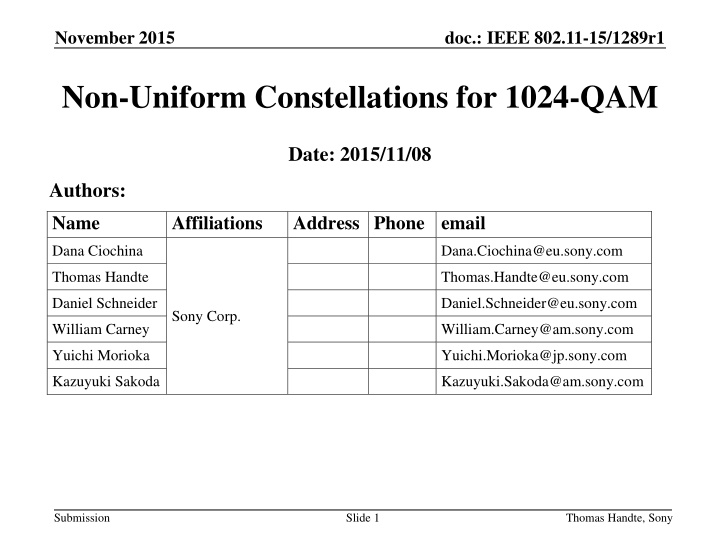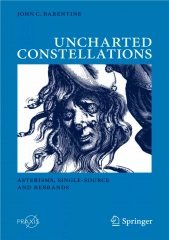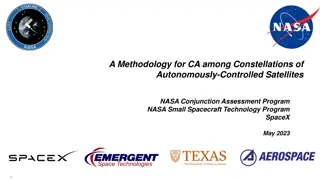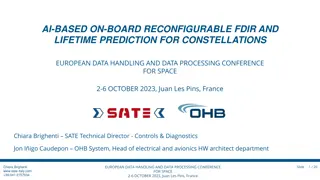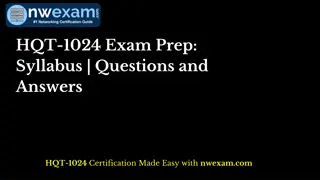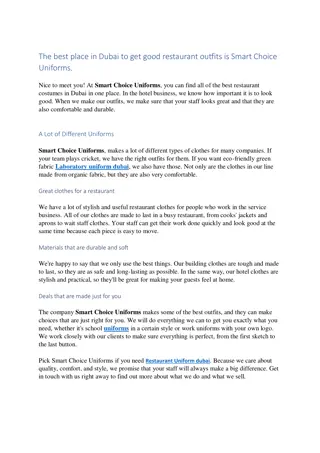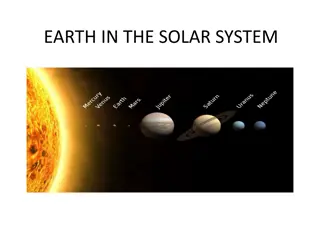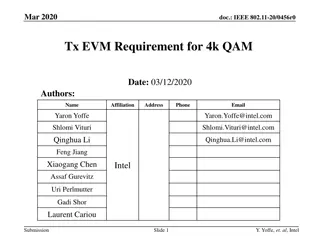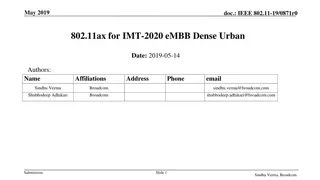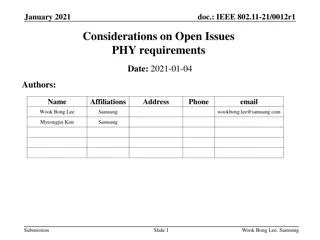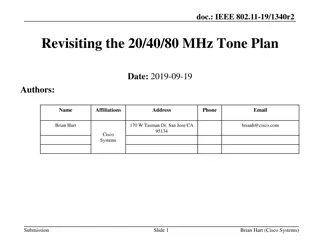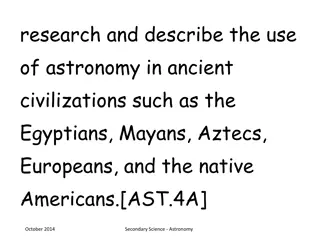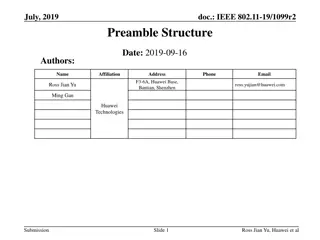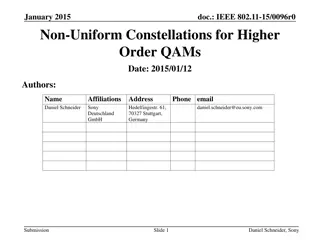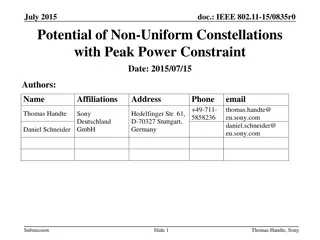Non-Uniform Constellations for 1024-QAM in 11ax Standard
IEEE 802.11-15/1289r1 discusses the advantages of using non-uniform constellations (NUCs) over uniform constellations (UCs) in the context of 1024-QAM for the 11ax standard. NUCs offer superior performance in various scenarios, including indoor environments, by providing increased spectral efficiency, higher throughput, and better robustness against impairments such as phase noise and quantization effects. The document outlines the motivation, complexity analysis, decoding comparisons, and performance results of NUCs for 1024-QAM, highlighting the potential enhancements in average throughput and selection probability of MCS. Different types of NUCs, such as 1D and 2D NUCs, are compared in terms of performance gains and complexity. Additionally, proposed NUCs for 1024-QAM aim to improve performance without requiring significant additional decoding complexity, offering optimized bit labeling and compatibility with existing WLAN systems without the need for additional blocks or dedicated bit interleavers.
Download Presentation

Please find below an Image/Link to download the presentation.
The content on the website is provided AS IS for your information and personal use only. It may not be sold, licensed, or shared on other websites without obtaining consent from the author.If you encounter any issues during the download, it is possible that the publisher has removed the file from their server.
You are allowed to download the files provided on this website for personal or commercial use, subject to the condition that they are used lawfully. All files are the property of their respective owners.
The content on the website is provided AS IS for your information and personal use only. It may not be sold, licensed, or shared on other websites without obtaining consent from the author.
E N D
Presentation Transcript
November 2015 doc.: IEEE 802.11-15/1289r1 Non-Uniform Constellations for 1024-QAM Date: 2015/11/08 Authors: Name Affiliations Address Phone email Dana.Ciochina@eu.sony.com Dana Ciochina Thomas Handte Thomas.Handte@eu.sony.com Daniel Schneider Daniel.Schneider@eu.sony.com Sony Corp. William Carney William.Carney@am.sony.com Yuichi Morioka Yuichi.Morioka@jp.sony.com Kazuyuki Sakoda Kazuyuki.Sakoda@am.sony.com Submission Slide 1 Thomas Handte, Sony
November 2015 doc.: IEEE 802.11-15/1289r1 Motivation 1024-QAM has been adopted for 11ax as an optional feature [1] 1024-QAM is an optional feature for SU and MU using resource units equal to or larger than 242 tones in 11ax. Advantages 25% increase in spectral efficiency compared to 256-QAM Throughput up to 1.25 Gbps per spatial stream (160MHz, code rate 5/6, short GI) 10 Gbps aggregate throughput with 8 spatial streams [2] It has been shown [2, 3] for uniform constellations (UCs) that 1024-QAM MCS are selected with very high probability in indoor scenarios 1024-QAM provides an average throughput gain of >20% in most indoor scenarios However, non-uniform constellations (NUCs) are superior to UCs NUCs provide SNR gains compared to UCs NUCs are more robust against impairments such as phase noise and quantization Performance of 1024-QAM in 11ax can be increased by NUCs Average throughput gain and selection probability of 1024-QAM MCS will increase Submission Slide 2 Thomas Handte, Sony
November 2015 doc.: IEEE 802.11-15/1289r1 Outline Details on the proposed NUCs for 1024-QAM Complexity Analysis Comparison of decoding complexity Performance Results AWGN channel w/ and w/o phase noise w/ and w/o quantization effects Performance in fading channels Submission Slide 3 Thomas Handte, Sony
November 2015 doc.: IEEE 802.11-15/1289r1 Introduction Different types of NUCs can be distinguished 1D NUC High level of symmetry Amplitude levels of real and imaginary part are the same Bit labels of real and imaginary part can be separated 2D NUC Quadrant symmetry Amplitude levels of real and imaginary part are independent Bit labels can not be separated between real and imaginary part Comparison of NUC types 1D NUC performance gain over UC same complexity as UC 2D NUC even larger performance gain over UCs [4] higher complexity than 1D NUCs or UCs 1D 16NUC for 3dB 1D NUC: 16-QAM 1 0.5 Im{xl} 0 -0.5 -1 -1 -0.5 0 0.5 1 Re{xl} 2D NUC: 16-QAM Submission Slide 4 Thomas Handte, Sony
November 2015 doc.: IEEE 802.11-15/1289r1 Proposed NUCs for 1024-QAM 1D NUCs Performance gain at negligible additional decoding complexity (see slide 7, [4]) Different NUCs for each code rate Optimized for FEC operating point with specific code rate (CR) Optimized bit labeling Matches optimally to existing .11 WLAN system No changes at FEC or other blocks required No need for a dedicated bit interleaver Submission Slide 5 Thomas Handte, Sony
November 2015 doc.: IEEE 802.11-15/1289r1 Proposed NUCs for 1024-QAM (cont.) ??? ??? 40 Figure shows an example ??? 30 NUC is defined by amplitudes ?1, ,?15 (?0= 1 assumed) 20 10 ??= ? ?? ?? 0 Q Details on amplitudes and bit labeling see Appendix -10 -20 -30 ??? -40 -40 -30 -20 -10 0 I 10 20 30 40 Submission Slide 6 Thomas Handte, Sony
November 2015 doc.: IEEE 802.11-15/1289r1 Decoding Complexity of 1D NUCs 1D NUC correspond to a UC with non-uniform amplitude levels Real and imaginary part can be independently demodulated In case of 1024-QAM, 2x32 metrics are sufficient for the demapping process which is the same for UCs No additional complexity Metric computation requires the consideration of the non-uniform shape Requires only a modification of the amplitude levels of the signal points within the demapper look-up tables No additional complexity 1D NUCs yield no additional decoding complexity Submission Slide 7 Thomas Handte, Sony
November 2015 doc.: IEEE 802.11-15/1289r1 Simulation Parameters 1024-QAM: Regular UC and NUC LDPC, approx. LLR Message length: 1000 bytes AWGN, channel model D Considered impairments: w/ and w/o phase noise (PN) PN model according to evaluation methodology [5] w/ and w/o quantization Fixed point quantization between FFT and demapper Performance compared at FER = 10-2 MCS 10 11 Coderate bit/symbol 3/4 5/6 10 10 Submission Slide 8 Thomas Handte, Sony
November 2015 doc.: IEEE 802.11-15/1289r1 Results: Influence of Phase Noise NUCs have similar degradation as UCs under PN influence NUCs are even more robust against PN than UCs Small additional NUC gain MCS11 CR 5/6 MCS10 CR 3/4 Submission Slide 9 Thomas Handte, Sony
November 2015 doc.: IEEE 802.11-15/1289r1 Results: Quantization Quantization between FFT and Demapper Fixed-point implementation Number format: sign + 1 bit pre comma + M bits post comma sgn a1 b1 b2 bM Submission Slide 10 Thomas Handte, Sony
November 2015 doc.: IEEE 802.11-15/1289r1 Results: Quantization (cont.) NUC gain is maintained in presence of quantization NUCs even show an additional gain compared to UCs for reasonable quantization here: SNR gain = 0 dB Submission Slide 11 Thomas Handte, Sony
November 2015 doc.: IEEE 802.11-15/1289r1 Results: Fading Channel Channel model D, time-varying NUCs show an additional gain compared to UCs in fading channel Submission Slide 12 Thomas Handte, Sony
November 2015 doc.: IEEE 802.11-15/1289r1 Conclusion Investigation of non-uniform constellations (NUCs) for 1024-QAM The proposed NUCs achieve a gain of 0.3 dB have no additional decoding complexity maintain / even increase their gain over UCs in presence of Phase noise Quantization Fading channel Submission Slide 13 Thomas Handte, Sony
November 2015 doc.: IEEE 802.11-15/1289r1 References 1. 11-15-0132-09-00ax Specification Framework for TGax 2. 11-15-1070-03-00ax 1024 QAM Proposal 3. 11-14-0624-00-00ax Investigation on 1024 QAM feasibility in 11ax 4. 11-15-0048-00-00ax Non-uniform Constellations for higher Order QAMs 5. 11-09-0451-15-00ac-tgac Functional requirements and evaluation methodology Submission Slide 14 Thomas Handte, Sony
November 2015 doc.: IEEE 802.11-15/1289r1 TABLES Submission Slide 15 Thomas Handte, Sony
November 2015 doc.: IEEE 802.11-15/1289r1 NUC for MCS10 (CR 3/4) 0 1 1 0 0 1 1 0 0 1 1 0 0 1 1 0 b3 0 0 0 0 1 1 1 1 1 1 1 1 0 0 0 0 b4 0 0 1 1 1 1 0 0 0 0 1 1 1 1 0 0 b5 Amplitude level ?0 ?1 ?2 ?3 ?4 ?5 ?6 ?7 ?8 ?9 ?10 ?11 ?12 ?13 ?14 ?15 0 0 0 0 0 0 0 0 0 0 0 0 0 0 0 0 b8 1 0 0 0 0 0 0 0 0 1 1 1 1 -9 -u4 0 1 -7 -u3 0 1 -5 -u2 1 1 -3 -u1 1 1 -1 -1 0 b9 real part 2.9667 4.9871 7.0015 9.0819 11.1960 13.3951 15.6735 18.0691 20.5980 23.2914 26.1728 29.2806 32.6657 36.4161 40.7366 Re(zq) -31 -u15 0 -29 -u14 1 -27 -u13 1 -25 -u12 0 -23 -u11 0 -21 -u10 1 -19 -u9 1 -17 -u8 0 -15 -u7 0 -13 -u6 1 -11 -u5 1 Uniform NUC b3 0 0 0 0 1 1 1 1 1 1 1 1 0 0 0 0 b4 0 0 1 1 1 1 0 0 0 0 1 1 1 1 0 0 b5 1 1 1 1 1 1 1 1 1 1 1 1 1 1 1 1 b8 1 1 1 1 3 u1 1 5 u2 1 7 u3 1 9 u4 1 1 1 0 0 19 u9 0 21 u10 0 0 0 0 29 u14 0 31 u15 b9 Re(zq) 11 u5 13 u6 15 u7 17 u8 23 u11 25 u12 27 u13 Uniform NUC 0 1 1 0 0 1 1 0 0 1 1 0 0 1 1 0 b0 0 0 0 0 1 1 1 1 1 1 1 1 0 0 0 0 b1 0 0 1 1 1 1 0 0 0 0 1 1 1 1 0 0 b2 0 0 0 0 0 0 0 0 1 1 1 1 1 1 1 1 b6 imaginary part 0 0 0 0 0 0 0 0 0 0 0 0 -9 -u4 0 0 -7 -u3 0 0 -5 -u2 1 0 -3 -u1 1 0 -1 -1 0 b7 Im(zq) -31 -u15 0 -29 -u14 1 -27 -u13 1 -25 -u12 0 -23 -u11 0 -21 -u10 1 -19 -u9 1 -17 -u8 0 -15 -u7 0 -13 -u6 1 -11 -u5 1 Uniform NUC b0 0 0 0 0 1 1 1 1 1 1 1 1 0 0 0 0 b1 0 0 1 1 1 1 0 0 0 0 1 1 1 1 0 0 b2 1 1 1 1 1 1 1 1 0 0 0 0 0 0 0 0 b6 1 1 1 1 3 u1 1 5 u2 1 7 u3 1 9 u4 1 11 u5 1 1 1 1 19 u9 1 21 u10 1 1 1 1 29 u14 1 31 u15 b7 Im(zq) 13 u6 15 u7 17 u8 23 u11 25 u12 27 u13 Uniform NUC Submission Slide 16 Thomas Handte, Sony
November 2015 doc.: IEEE 802.11-15/1289r1 NUC for MCS11 (CR 5/6) 0 1 1 0 0 1 1 0 0 1 1 0 0 1 1 0 b0 0 0 0 0 0 0 0 0 1 1 1 1 1 1 1 1 b3 0 0 1 1 1 1 0 0 0 0 1 1 1 1 0 0 b5 Amplitude level ?0 ?1 ?2 ?3 ?4 ?5 ?6 ?7 ?8 ?9 ?10 ?11 ?12 ?13 ?14 ?15 0 0 0 0 0 0 0 0 0 0 0 0 0 0 0 0 b7 1 0 0 0 0 1 1 1 1 1 1 1 1 -9 -u4 0 0 -7 -u3 0 0 -5 -u2 1 0 -3 -u1 1 0 -1 -1 0 b8 real part 2.9902 5.0100 7.0446 9.1283 11.2570 13.4588 15.7417 18.1292 20.6379 23.2916 26.1151 29.1412 32.4176 36.0267 40.1583 Re(zq) -31 -u15 0 -29 -u14 1 -27 -u13 1 -25 -u12 0 -23 -u11 0 -21 -u10 1 -19 -u9 1 -17 -u8 0 -15 -u7 0 -13 -u6 1 -11 -u5 1 Uniform NUC b0 1 1 1 1 1 1 1 1 0 0 0 0 0 0 0 0 b3 0 0 1 1 1 1 0 0 0 0 1 1 1 1 0 0 b5 1 1 1 1 1 1 1 1 1 1 1 1 1 1 1 1 b7 0 1 1 0 3 u1 0 5 u2 0 7 u3 1 9 u4 1 1 1 1 1 19 u9 1 21 u10 1 0 0 0 29 u14 0 31 u15 b8 Re(zq) 11 u5 13 u6 15 u7 17 u8 23 u11 25 u12 27 u13 Uniform NUC 0 0 0 0 0 0 0 0 1 1 1 1 1 1 1 1 b1 0 0 0 0 1 1 1 1 1 1 1 1 0 0 0 0 b2 0 0 0 0 0 0 0 0 0 0 0 0 0 0 0 0 b4 0 0 1 1 1 1 0 0 0 0 1 1 1 1 0 0 b6 imaginary part 0 1 1 0 0 1 1 0 0 1 1 0 -9 -u4 0 0 -7 -u3 0 1 -5 -u2 0 1 -3 -u1 0 0 -1 -1 0 b9 Im(zq) -31 -u15 1 -29 -u14 1 -27 -u13 1 -25 -u12 1 -23 -u11 1 -21 -u10 1 -19 -u9 1 -17 -u8 1 -15 -u7 0 -13 -u6 0 -11 -u5 0 Uniform NUC b1 0 0 0 0 1 1 1 1 1 1 1 1 0 0 0 0 b2 1 1 1 1 1 1 1 1 1 1 1 1 1 1 1 1 b4 0 0 1 1 1 1 0 0 0 0 1 1 1 1 0 0 b6 0 1 1 1 3 u1 1 5 u2 0 7 u3 0 9 u4 1 11 u5 1 0 0 1 19 u9 1 21 u10 0 0 1 1 29 u14 0 31 u15 b9 Im(zq) 13 u6 15 u7 17 u8 23 u11 25 u12 27 u13 Uniform NUC Submission Slide 17 Thomas Handte, Sony
November 2015 doc.: IEEE 802.11-15/1289r1 Straw Poll #1 Do you agree that is desirable to achieve the maximum possible gain for 1024-QAM (e.g. make also use of non- uniform constellations)? Y/N/A Submission Slide 18 Thomas Handte, Sony
November 2015 doc.: IEEE 802.11-15/1289r1 Straw Poll #2 Do you agree that non-uniform constellations shall be used for 1024-QAM? Y/N/A Submission Slide 19 Thomas Handte, Sony
November 2015 doc.: IEEE 802.11-15/1289r1 APPENDIX Submission Slide 20 Thomas Handte, Sony
November 2015 doc.: IEEE 802.11-15/1289r1 Example: How to get the bit labeling Real part: ?2 ?0 ?9= (1 1 1 1 1 1 0 0 0 0) 40 Identify amplitude levels of real and imaginary part of a particular signal point Consider mapping table (see next slide) Identify both partial bit sequences & arrange as indicated ?0 ?9= (1 1 1 1 1 1 0 0 0 0) ?1,?2,?3,?6,?7correspond to real ?0,?4,?5,?8,?9correspond to imag 30 Imag. part: ?13 20 10 0 Q -10 -20 -30 -40 -40 -30 -20 -10 0 I 10 20 30 40 Submission Slide 21 Thomas Handte, Sony
November 2015 doc.: IEEE 802.11-15/1289r1 Example: How to get the bit labeling (cont.) 0 1 1 0 0 1 1 0 0 1 1 0 0 1 1 0 b1 0 0 0 0 0 0 0 0 1 1 1 1 1 1 1 1 b2 0 0 1 1 1 1 0 0 0 0 1 1 1 1 0 0 b3 0 0 0 0 0 0 0 0 0 0 0 0 0 0 0 0 b6 0 0 0 0 1 1 1 1 1 1 1 1 -9 -u4 0 0 -7 -u3 0 0 -5 -u2 1 0 -3 -u1 1 0 -1 -1 0 b7 real part Re(zq) -31 -u15 0 -29 -u14 1 -27 -u13 1 -25 -u12 0 -23 -u11 0 -21 -u10 1 -19 -u9 1 -17 -u8 0 -15 -u7 0 -13 -u6 1 -11 -u5 1 Uniform NUC b1 1 1 1 1 1 1 1 1 0 0 0 0 0 0 0 0 b2 0 0 1 1 1 1 0 0 0 0 1 1 1 1 0 0 b3 1 1 1 1 1 1 1 1 1 1 1 1 1 1 1 1 b6 0 1 1 0 3 u1 0 5 u2 0 7 u3 1 9 u4 1 1 1 1 1 19 u9 1 21 u10 1 0 0 0 29 u14 0 31 u15 b7 Re(zq) 11 u5 13 u6 15 u7 17 u8 23 u11 25 u12 27 u13 Uniform NUC 0 1 1 0 0 1 1 0 0 1 1 0 0 1 1 0 b0 0 0 1 1 1 1 0 0 0 0 1 1 1 1 0 0 b4 0 0 0 0 0 0 0 0 0 0 0 0 0 0 0 0 b5 0 0 0 0 1 1 1 1 1 1 1 1 0 0 0 0 b8 imaginary part 0 0 0 0 0 0 0 0 1 1 1 1 -9 -u4 0 1 -7 -u3 0 1 -5 -u2 1 1 -3 -u1 1 1 -1 -1 0 b9 Im(zq) -31 -u15 0 -29 -u14 1 -27 -u13 1 -25 -u12 0 -23 -u11 0 -21 -u10 1 -19 -u9 1 -17 -u8 0 -15 -u7 0 -13 -u6 1 -11 -u5 1 Uniform NUC b0 0 0 1 1 1 1 0 0 0 0 1 1 1 1 0 0 b4 1 1 1 1 1 1 1 1 1 1 1 1 1 1 1 1 b5 0 0 0 0 1 1 1 1 1 1 1 1 0 0 0 0 b8 1 1 1 1 3 u1 1 5 u2 1 7 u3 1 9 u4 1 11 u5 1 1 0 0 19 u9 0 21 u10 0 0 0 0 29 u14 0 31 u15 b9 Im(zq) 13 u6 15 u7 17 u8 23 u11 25 u12 27 u13 Uniform NUC Submission Slide 22 Thomas Handte, Sony
